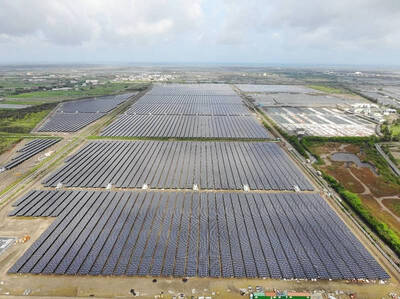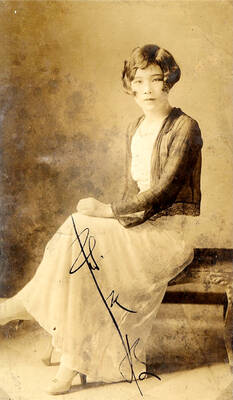On Friday, a gusty afternoon in the expanse of Taipei’s Huazhong Bridge Sports Park (台北市華中橋運動公園) on the banks of the Xindian River (新店溪), there were an unusually large number of people throwing Frisbee-like discs at metal baskets. They were preparing for the Disc Golf Asian Open, the final rounds of which take place today.
Participating is an international field that includes Japan’s top player Manabu Kajiyama and current world champion Dave Feldberg.
At the tee, Feldberg showed off his powerful drives to an appreciative audience, with throws measuring over 150m. He had with him a bag containing a wide variety of discs for different kinds of shots. The hole begins with a “driver” disc and a huge windup to get the disc down the fairway, then moving forward to the lie, this is switched for a “putter,” a disc of slightly different design, with which he makes a carefully judged toss to approach the “hole,” a metal basket with a structure of chains above it to catch the disc.
Feldberg makes his pick for each shot from nearly 20 discs neatly arrayed in his golf bag. The design and balance of each is slightly different, with drivers weighted to break to right or left, and rims designed for different holds.
Back at a rest area at Hole 18, Feldberg holds an impromptu master class for other competitors, demonstrating the action and grip that have made him the best disc golfer in the world.
Feldberg picked up the sport in 1997 after shattering his foot playing college soccer. He turned pro in 2000 and now divides his time between competition and promoting the disc golf.
In Taiwan, he is playing a slightly different game from the one he is used to in the US, which goes some way to reducing his advantage both in power and experience. Here and in Japan 150g discs are the standard, whereas in the US the game is played with discs weighing up to 180g, which require more power, but are easier to handle in the wind.
For this reason, despite the windy conditions on Friday, Kuan Chen (陳冠宏), the executive director of the Taiwan Disc Golf Association (台灣飛盤高爾夫聯盟) hoped for stronger gusts during competition, which would be an advantage to local competitors more familiar with the lighter discs.
According to Chen, Taiwan has around 50 competition level players of the sport, and though there is an active tournament circuit, exposure to top players like Feldberg is limited. Feldberg attributes this primarily to the different class of discs used, which discourages US and European players from venturing into Asia. “After competing with the 150[g] discs, it hurts your game for a month or so after you get back,” he said.
Chen and the Taiwan Disc Golf Association are pushing to establish regular monthly competitions at locations including Lungmen Park (龍門公園) in the Northeast Coast Scenic Area (東北角風景區) and the Dahan Bridge River Park (大漢橋段河濱公園) in Banciao City (板橋市).
Jeff Kennedy, a competitor from Las Vegas, Nevada, who normally plays in the seniors division in the US, extolled the accessibility of disc golf. “When you’re in high school, you have your buddies to go and play softball, football, basketball with. But you need 10 people and up. When you get older and stuff, it’s harder to get that many people together. [With disc golf], you call up a buddy or two and say you’ll meet them at the park for a couple of hours,” he said.
Feldberg emphasized the relative inexpensiveness of the sport, for unlike regular golf, which requires a considerable investment in both equipment and course fees, disc golf only requires a couple of plastic discs and a park to get started.
Chen invited Feldberg and the competitors over to bolster the reputation of disc golf as a proper sport in Taiwan. While Feldberg emphasized the inclusiveness of disc golf, he also pointed out that playing seriously involved considerable physical effort and a high level of coordination.
Brock Pitzer, another US player in Taiwan for the tournament, described the various techniques that can be used to enhance accuracy, as Feldberg, Manabu and Erich Altoray from Sweden practiced putting through a low stand of trees. The complexities of jump putts and the use of a knuckleball style pitch, and the intricacies of dealing with wind and the natural banking of the disc revealed disc golf to have plenty of technical aspects to engross the serious player.
As for Feldberg’s drives, which leave his hand at 128kph and have reached over 180m, these are feats of athleticism that cannot be sniffed at.
Feldberg believes that disc golf is, in a term he aims to trademark, “the golf of the next generation.” Today at Huazhong Sports Park, he will be doing his best to show that fun for the family and a serious sport can be combined. An 18-hole qualifying round begins at 8:30am, with 9-hole semifinals and finals in the afternoon. More information about the competition can be found at ezflyingdiscs.com.tw.

Every now and then, it’s nice to just point somewhere on a map and head out with no plan. In Taiwan, where convenience reigns, food options are plentiful and people are generally friendly and helpful, this type of trip is that much easier to pull off. One day last November, a spur-of-the-moment day hike in the hills of Chiayi County turned into a surprisingly memorable experience that impressed on me once again how fortunate we all are to call this island home. The scenery I walked through that day — a mix of forest and farms reaching up into the clouds

With one week left until election day, the drama is high in the race for the Chinese Nationalist Party (KMT) chair. The race is still potentially wide open between the three frontrunners. The most accurate poll is done by Apollo Survey & Research Co (艾普羅民調公司), which was conducted a week and a half ago with two-thirds of the respondents party members, who are the only ones eligible to vote. For details on the candidates, check the Oct. 4 edition of this column, “A look at the KMT chair candidates” on page 12. The popular frontrunner was 56-year-old Cheng Li-wun (鄭麗文)

“How China Threatens to Force Taiwan Into a Total Blackout” screamed a Wall Street Journal (WSJ) headline last week, yet another of the endless clickbait examples of the energy threat via blockade that doesn’t exist. Since the headline is recycled, I will recycle the rebuttal: once industrial power demand collapses (there’s a blockade so trade is gone, remember?) “a handful of shops and factories could run for months on coal and renewables, as Ko Yun-ling (柯昀伶) and Chao Chia-wei (趙家緯) pointed out in a piece at Taiwan Insight earlier this year.” Sadly, the existence of these facts will not stop the

Oct. 13 to Oct. 19 When ordered to resign from her teaching position in June 1928 due to her husband’s anti-colonial activities, Lin Shih-hao (林氏好) refused to back down. The next day, she still showed up at Tainan Second Preschool, where she was warned that she would be fired if she didn’t comply. Lin continued to ignore the orders and was eventually let go without severance — even losing her pay for that month. Rather than despairing, she found a non-government job and even joined her husband Lu Ping-ting’s (盧丙丁) non-violent resistance and labor rights movements. When the government’s 1931 crackdown